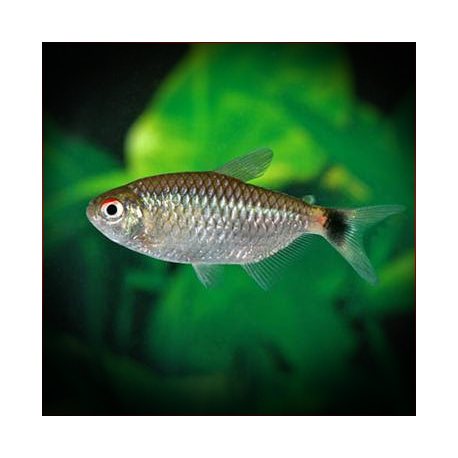More info
Datasheet
| Minimum Tank Size | 70 litres / 18.49 US gallons |
| Maximum Size | 5.0cm / 1.97inches |
| Temperature | 24°C / 75.20°F - 28°C / 82.40°F |
| Hardness | 1-12ºdH |
| pH | 5.5-7.2 |
General Description
The Glass Tetra, scientifically known as Moenkhausia Oligolepis, is a species closely resembling the red-eyed tetra. This fish, part of the Characidae family, is relatively less common in the aquarium trade. Its taxonomic classification is currently uncertain, residing in the Moenkhausia genus. It has a maximum size of about 5.0cm and is native to various South American regions such as Venezuela, Guyana, and Brazil.
Aquarium Setup
To replicate its natural habitat, a biotope setup with river sand, driftwood, and dried leaves is recommended. Aquatic plants are not necessary, but the addition of dried leaves and aquarium-safe peat in the filter can mimic blackwater conditions. This species thrives in slightly acidic water with a pH range of 5.5-7.2, a hardness of 1-12 dH, and a temperature between 24-28°C. It is advisable to maintain dim lighting in the tank, and regular water changes are essential.
Behaviour
Glass Tetras are peaceful and should not be housed with aggressive or significantly larger tankmates. They are shoaling fish by nature and do best when kept in groups of at least six individuals. Generally, they coexist well with other South American species like Hemigrammus, Hyphessobrycon, and Corydoras. Maintaining them in a community tank alongside smaller rasboras, barbs, or dwarf cichlids is also viable.
Feeding and Diet
Feeding the Glass Tetra is uncomplicated, as they accept various food types eagerly. A diet comprising small live or frozen foods like bloodworms, Daphnia, and brine shrimp, along with dried flakes and granules, sustains their health and vibrant colors. Regular feeding schedules contribute to the overall well-being of these fish.
Reproduction & Dimorphism
Breeding Glass Tetras involves setting up a separate tank with suitable conditions like dim lighting and aquatic plants for egg deposition. The adults should be removed post-spawning to prevent egg consumption. Fry hatch within 24-36 hours and require infusoria-type food initially, progressing to microworms or brine shrimp nauplii as they grow. Adult females exhibit a fuller body compared to males.
Habitat and Distribution
These tetras inhabit slow-moving rivers, tributaries, and floodplain lakes, showing a preference for acidic water conditions. They are distributed across northern South America, spanning countries such as Peru, Suriname, and French Guiana. Maintaining them in conditions akin to their natural habitat ensures their well-being in captivity.

